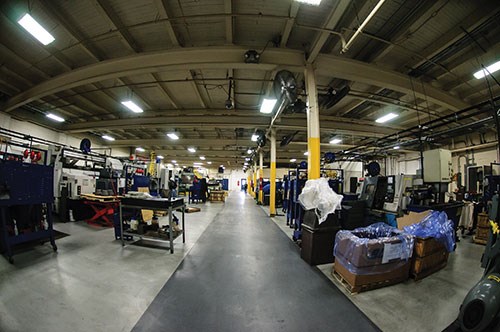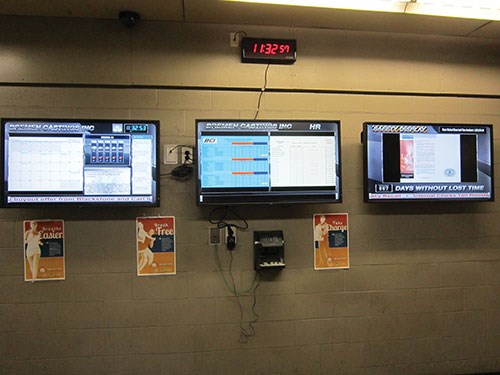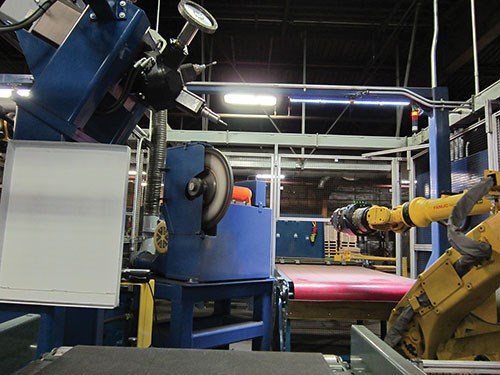Taking Health Care into Your Own Hands
Bremen Castings Inc. recently established a convenient, on-site clinic to better manage health care costs. The cash-free operation looks to be a win-win for the company and its nearly 300 employees in more ways than one.
Challenges sometimes spur leading companies to establish effective, albeit atypical, solutions to their problems. Bremen Castings Inc. (BCI) is a case in point. Established in Bremen, Indiana in 1939, BCI has leveraged new foundry and machining technology to become a highly competitive supplier of machined ductile and gray iron castings to a myriad of customers. It is well-served by its willingness to try new manufacturing and management approaches. This business ethos has recently led BCI to adopt an interesting strategy to manage rising health care costs that’s rare for a company of its size.
Led by JB Brown, who became company president in 2005, the fourth-generation, family-owned business with just less than 300 employees has established an on-site health care clinic. (Technically it’s “near-site” because the clinic is in a new building BCI constructed across the street from its foundry and machine shop facilities.) The clinic enables BCI to provide insured employees and their dependents (totaling approximately 600 patients) free primary care, generic prescription drugs and, perhaps most importantly, personal health coaching to improve their overall wellness.
Historically, only very large companies have invested in private clinics such as this. However, BCI seems to be at the forefront of a trend whereby smaller companies are adopting the cash-free, on-site clinic model to enjoy the same benefits as big businesses. Although BCI’s clinic has been open only since last November, the company and its employees have quickly come to recognize the value of this alternate approach to health care, as I learned during a recent visit to the company’s northern Indiana facilities.
Finding Help
In 2011, Mr. Brown read an article about Reliable Production Machining & Welding, a machine shop that had established its own on-site health care clinic. As it turns out, that shop is located just southeast of BCI in Kendallville, Indiana, so BCI’s executive team visited there to learn more about its clinic. Afterward, Mr. Brown spoke with his employees to get their thoughts about establishing a clinic at BCI. During those chats, he found that many employees did not get regular medical exams while others were reluctant to take the time to visit a doctor even when they were ill.
Agreeing that an on-site clinic might make sense for these and a number of other reasons, BCI management worked with its insurance broker to search for health care companies that specialize in setting up and managing on-site clinics. After interviewing a handful of these companies, BCI chose to partner with Activate Health Care, headquartered in Indianapolis, Indiana. Mr. Brown says one aspect of Activate’s model he appreciated was that the clinic could be tailored to meet BCI’s specific needs. It would also be possible for employees and their dependents to visit any of Activate’s other nine Midwest clinic locations, which wasn’t possible with other health care companies’ proposed plans. Plus, BCI could eventually partner with other area businesses to share the clinic and its operating costs.
Peter Dunn, a principal at Activate, says his company’s strategy offers more than convenience and reduced primary care costs for the employer and employees. It takes a proactive, integrated approach to managing and guiding patient care with the goal of improving patients’ overall health. For example, Activate clinics review two years of medical claims for each patient, perform a health risk assessment and carry out a tailored lab test so the doctor knows a great deal about a patient’s health prior to a comprehensive, annual physical. The up-front diagnostic work combined with the physical enables the clinics to develop individually tailored health goals and action plans for each patient. A nurse practitioner/health coach then provides support for patients to reach their goals.
Mr. Dunn says BCI’s operation is one of the premier clinics Activate has helped launch. The following points highlight the decisions made to create BCI’s clinic and how the clinic health care program was implemented.
Location
Location—The clinic could have been located within BCI’s foundry facility. However, space there was already at a premium and BCI also needed a larger meeting and training area. Therefore, the company decided to purchase and raze an abandoned house catty-corner to its foundry and erect a new office building to accommodate the clinic. Although Activate reviewed BCI’s needs and requested 1,100 square feet of clinic space, BCI chose to dedicate 2,100 of the new building’s 3,800 square feet to the clinic. It used the remainder of the space to create a meeting/training room on the main level and plans to create a fitness area in the building’s full basement.
The clinic has three examination rooms, a drug testing room, a blood draw room, a doctor’s office, a nurse practitioner’s office, an educational room with health-related books and DVDs, and a lobby with two computer stations that employees use to complete their health risk assessments. Activate guaranteed that a patient’s wait time would be less than 15 minutes, so there are only two patient chairs in the lobby.
Equipment
Activate specified the equipment required for the clinic based on BCI’s needs. It also suggested the types and number of drugs to keep on hand based on employees’ past usage. The clinic now stocks 150 drugs available by prescription to patients. BCI is able to purchase generic drugs that are 90 percent below retail cost in many cases. Its clinic also offers immunization shots for patients over 12 years old. Mr. Brown says total clinic startup cost is tough to determine because clinic space takes up just a portion of the new building. However, he estimates clinic startup cost was approximately $120,000 including the purchase of furniture, equipment, drugs, computers and so on.
Staffing
The number of patients largely determines the staffing level and operating hours for these types of clinics. BCI’s clinic is open 40 hours per week with one full-time nurse practitioner/health coach and two medical assistants (one is bilingual to help communicate with Spanish-speaking employees). The doctor visits once a week, spending the rest of the time at other Activate clinics. BCI is currently the sole user of its clinic, although it is looking to partner with other companies to share operating expenses. BCI Director of Human Resources Carol Senour says the clinic’s current number of patients would have to double in order to have a full-time doctor at its location. To that end, BCI recently held an open house to enable nearby companies to tour the clinic and learn more about its advantages.
Program
The clinic is available to BCI employees (and families) who are part of the company’s insurance plan. Clinic participants who complete an online health risk assessment receive a reduction in their insurance deductible, bringing it down to $500 single/$1,000 family. Employees on the company’s insurance plan who choose to opt out of the clinic have a higher deductible of $2,500 single/$5,000 family.
For each patient, the program begins with a review of past medical claims, an online health risk assessment, tailored lab tests and a physical. Following that, the nurse practitioner/health coach spends a couple of hours with the patient to review the results and determine goals and action plans based on the patient’s prime health issues, which can include weight, stress, cholesterol level, blood pressure and so on. Patients (employees and family members) can receive as much as $200 each year from BCI for meeting their goals.
Communication
BCI and the clinic operate as separate businesses. However, Mrs. Senour is the prime liaison between both entities, meeting with the clinic team weekly to discuss issues and proposed changes to services. She also follows up with patients to ensure that they are meeting their obligations in terms of health risk assessments and scheduled visits. The clinic sends her monthly reports listing patient activity as well as treatments and drugs that have been administered.
Determining ROI
When considering the on-site clinic model, it can be challenging to get a firm handle as to when a return on investment (ROI) may be realized. Hard values can be calculated by reviewing past patient activity to estimate direct cost savings when that past activity is applied to the on-site model with lower costs for drugs, diagnostic procedures, etc. However, there’s also a soft ROI element that is more difficult to determine, such as the effect of improved employee attendance, workforce health, clinic convenience and so on. That said, Mr. Brown believes BCI will realize clinic ROI in 3.5 to 4 years.
This is important from a business perspective, but Mr. Brown asks how do you place a value on possibly avoiding a significant medical issue? He cites one example in which an initial clinic physical revealed that a man who had not had a checkup in years unknowingly had exceedingly high blood pressure. Were it not for the clinic, he likely would not have gotten the medication and counseling that now enables him to feel and sleep better as well as increase his overall health. Plus, he paid nothing out of pocket for his improved wellness.
Health and Safety Go Hand-in-Hand
BCI’s efforts to maintain a safe manufacturing environment complement its proactive approach to health care and employee wellness. The company has adopted a zero-accident culture, believing that every accident is, indeed, preventable. In 2010, it hired a safety manager to establish programs to that end. Mr. Brown says the “near-miss” program has been its most effective safety initiative thus far. A near-miss could be anything ranging from a puddle of water to a wire or cable that could cause someone to trip. The company set up an email system enabling employees to report any such condition that could possibly lead to an accident to management and the safety committee. After review, the safety manager starts the corrective action process. Mr. Brown says 95 percent of problems are solved within a day.
He admits that it was a bit challenging to get people on board with documenting near-misses or potential safety hazards. However, it’s gotten to the point that employees have become very picky (in a good way) at identifying safety issues, which has led to a safer working environment at both the foundry and machine shop. BCI has invested a good deal of money into remedying potential hazards, but the efforts are paying off. In fact, the company recently surpassed 1,000,000 employee hours without a lost-time accident, which is impressive given manufacturing’s inherent workplace dangers.
Looking More to Automation
All of the aforementioned efforts have the company looking at equipment in different ways, too. In July 2012, it completely revamped its foundry cleaning room, where previously employees manually ground flash from castings. This involved a great deal of physical work and posed threats for particles in eyes, pinched fingers and back injuries. Today, this work is performed via automated equipment including four FANUC robots with vision systems to pick castings from a conveyor and grind them. Each of the two most recently installed FANUC robot cells also has a tool turret to perform value-adding, first-op machining work. Employees still manually load the cells, so automation didn’t drive them out of a job. Automation did, however, reduce the risk for injury while making grinding operations more consistent and efficient. Two more similar robot cells will soon be added.
Related Content
In Moldmaking, Mantle Process Addresses Lead Time and Talent Pool
A new process delivered through what looks like a standard machining center promises to streamline machining of injection mold cores and cavities and even answer the declining availability of toolmakers.
Read MoreA Career at the Top Helps Rebuild a Job Shop
A new approach to management propels expansion into Swiss-type and multitasking machining work.
Read MoreHow to Grow the Business with Real-Time Job Status Data
ERP systems that focus on making data more accessible can improve communication within a shop, reducing wasteful errors and improving capacity.
Read MoreIMTS Takeaways From the Modern Machine Shop Editorial Team
The first in-person IMTS in four years left the MMS editorial staff with a lot to digest. Here are a few of our takeaways from the show floor.
Read MoreRead Next
3 Mistakes That Cause CNC Programs to Fail
Despite enhancements to manufacturing technology, there are still issues today that can cause programs to fail. These failures can cause lost time, scrapped parts, damaged machines and even injured operators.
Read MoreThe Cut Scene: The Finer Details of Large-Format Machining
Small details and features can have an outsized impact on large parts, such as Barbco’s collapsible utility drill head.
Read More
.jpg;width=70;height=70;mode=crop)


















.png;maxWidth=300;quality=90)



.png;maxWidth=300;quality=90)














